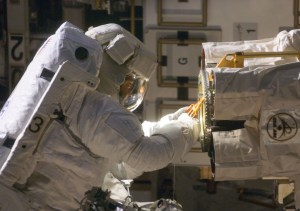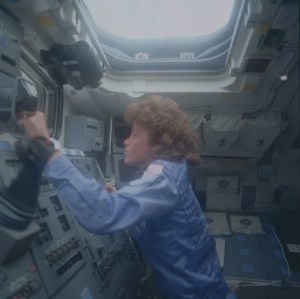On its fifth trip into space in November 1982, space shuttle Columbia’s STS-5 mission set a number of firsts. NASA managers considered this the first operational flight of the space shuttle, following completion of the four Orbital Flight Tests. For the first time, four astronauts rode into space in the same spacecraft, Commander Vance D. Brand, Pilot Robert F. Overmyer, and William B. Lenoir and Joseph P. Allen, the first two mission specialists to fly. The mission deployed the first two satellites for commercial customers. The mission’s plan also included the first spacewalk of the space shuttle program, but independent hardware failures in both spacesuits prevented the spacewalk from taking place. The mission also included three student experiments.
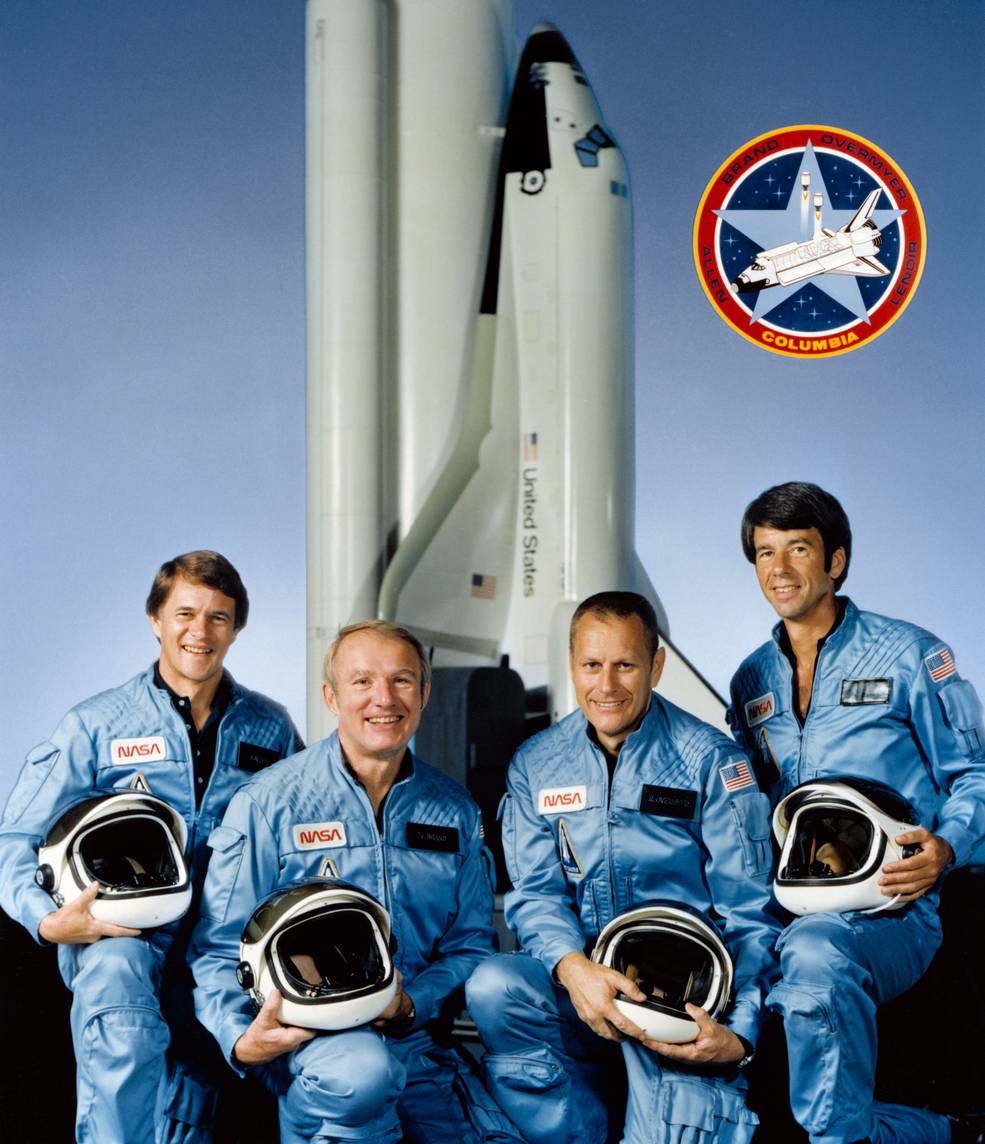
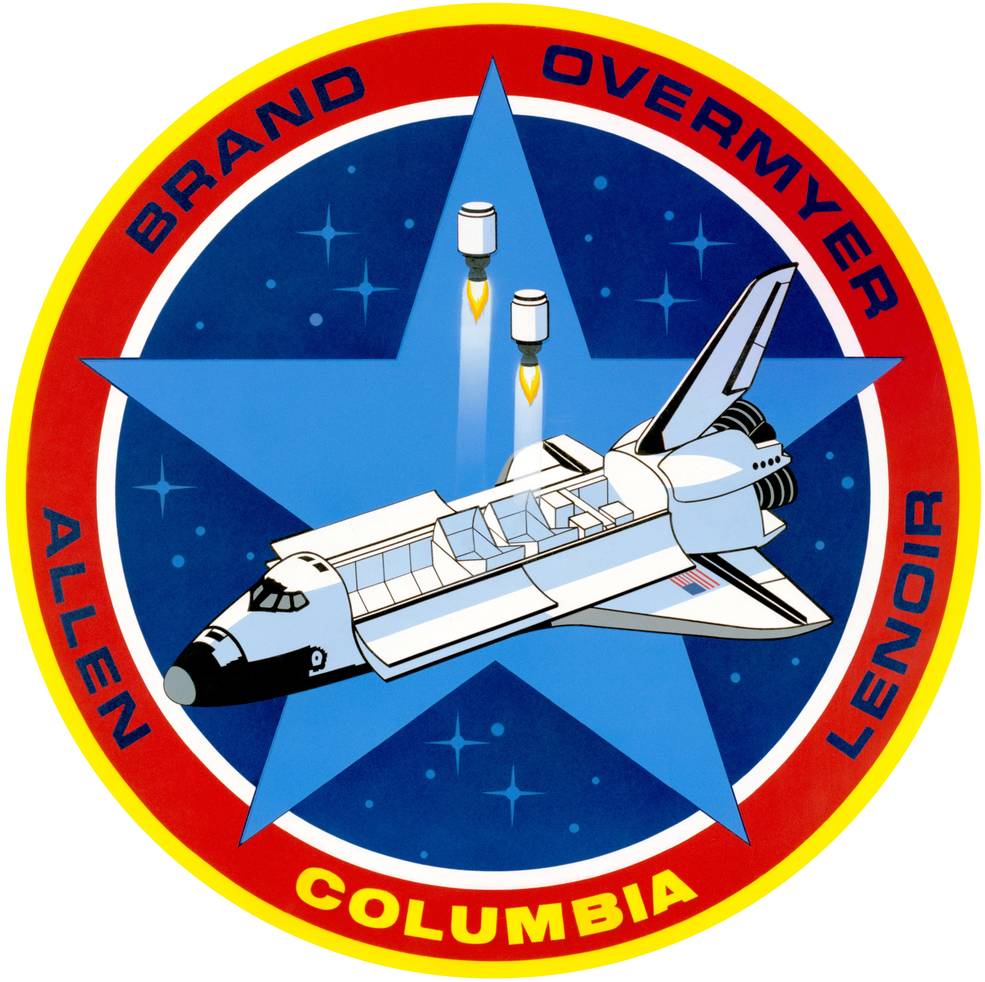
Left: Official photo of the STS-5 crew of Joseph P. Allen, left, Vance D. Brand, Robert F. Overmyer, and William B. Lenoir. Right: Official STS-5 crew patch.
Space shuttle Columbia landed at Edwards Air Force Base (AFB) in California on July 4, 1982, to end the STS-4 mission and conclude the Orbiter Flight Test program. Ground crews returned the orbiter to NASA’s Kennedy Space Center (KSC) in Florida, arriving on July 15, and towed it to the Orbiter Processing Facility (OPF). In the OPF, workers modified Columbia to enable it to fly a larger crew, including deactivating the two ejection seats on the flight deck. They also removed the Remote Manipulator System robotic arm and installed equipment in the payload bay to accommodate the two satellites planned for deployment on STS-5. The same day that Columbia arrived at KSC, workers in the Vehicle Assembly Building (VAB) began stacking the Solid Rocket Boosters (SRBs) for the mission. They completed stacking of the SRBs on Aug. 16 and added the External Tank (ET) on Aug. 20. After technicians finished Columbia’s refurbishment in the OPF, workers towed it to the VAB on Sept. 9 and stacked it with the SRBs and ET the next day. Columbia rolled out to Launch Pad 39A on Sept. 21. The mission’s two communications satellites, Telesat Canada’s Anik C3 and Satellite Business Systems-3 (SBS-3), arrived at KSC on July 20, and workers began processing them in the Vertical Processing Facility on Sept. 10 and 22, respectively.
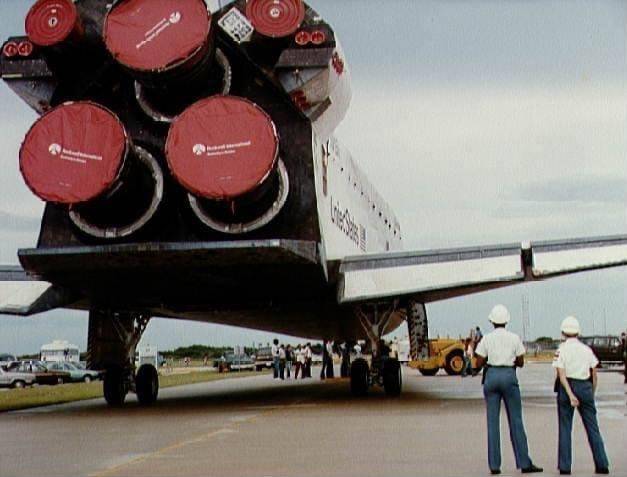

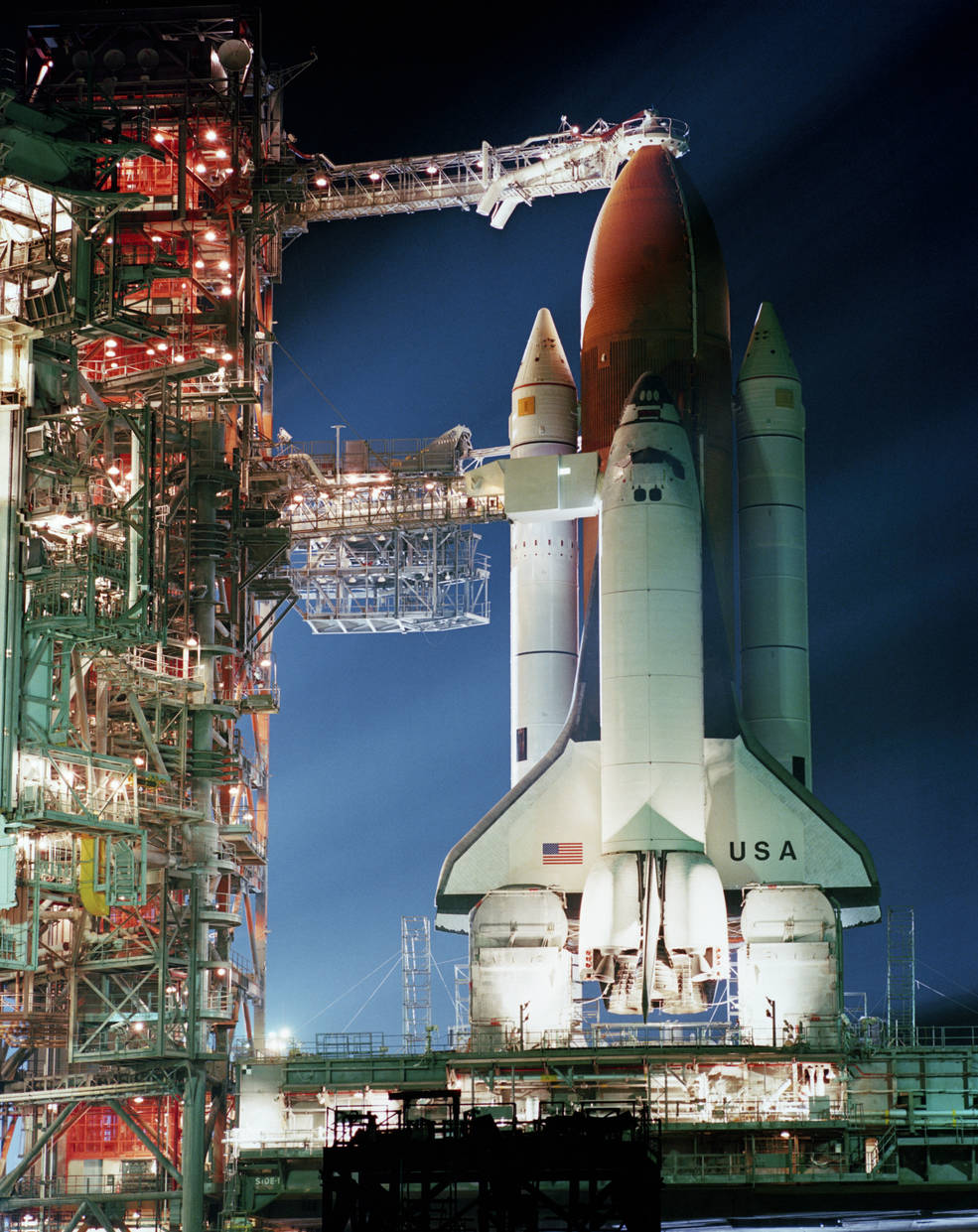
Left: Space shuttle Columbia during the transfer from the Orbiter Processing Facility to the Vehicle Assembly Building at NASA’s Kennedy Space Center in Florida. Middle: Columbia, mated with its External Tank and twin Solid Rocket Boosters, makes its way to Launch Pad 39A. Right: Columbia on Pad 39A.
The four-man STS-5 crew participated in the Terminal Countdown Demonstration Test on Sept. 24. Workers placed the two satellites in Columbia’s cargo bay on Oct. 18. The 100-hour countdown for STS-5 commenced on Nov. 7, with engineers and managers in Firing Room 1 of the Launch Control Center monitoring the activities. Flying in from Houston’s Ellington AFB, the four astronauts touched down at Patrick AFB near KSC on Nov. 9. To prepare for the launch two days later, they reviewed their mission plan and Brand and Overmyer practiced landings in the Shuttle Training Aircraft. On launch morning, the four ate the traditional breakfast with mission managers, then rode the astronaut van to the launch pad and boarded Columbia.
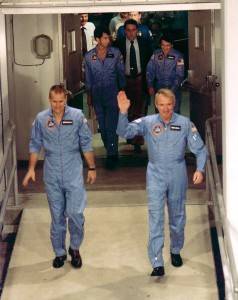
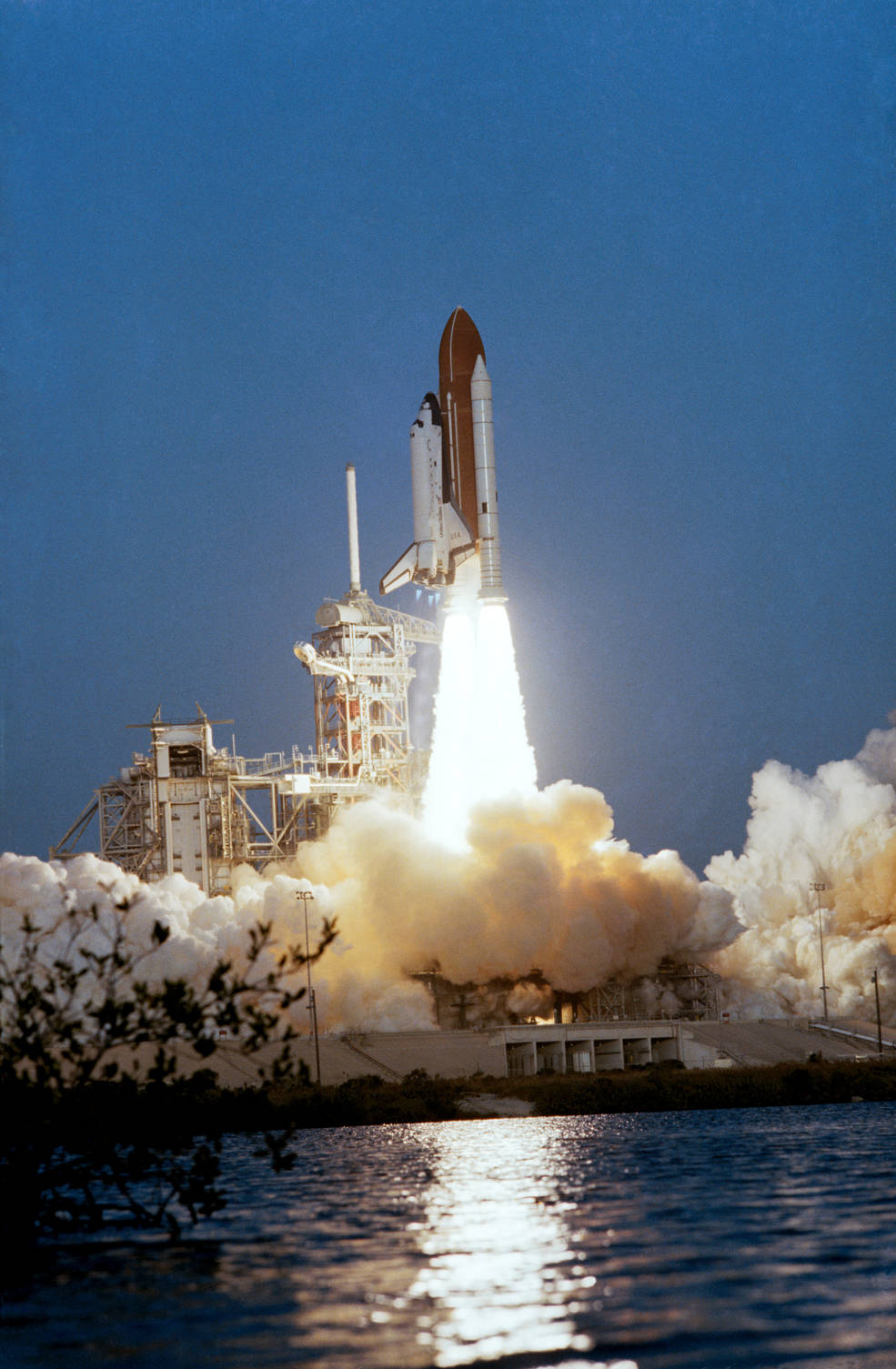
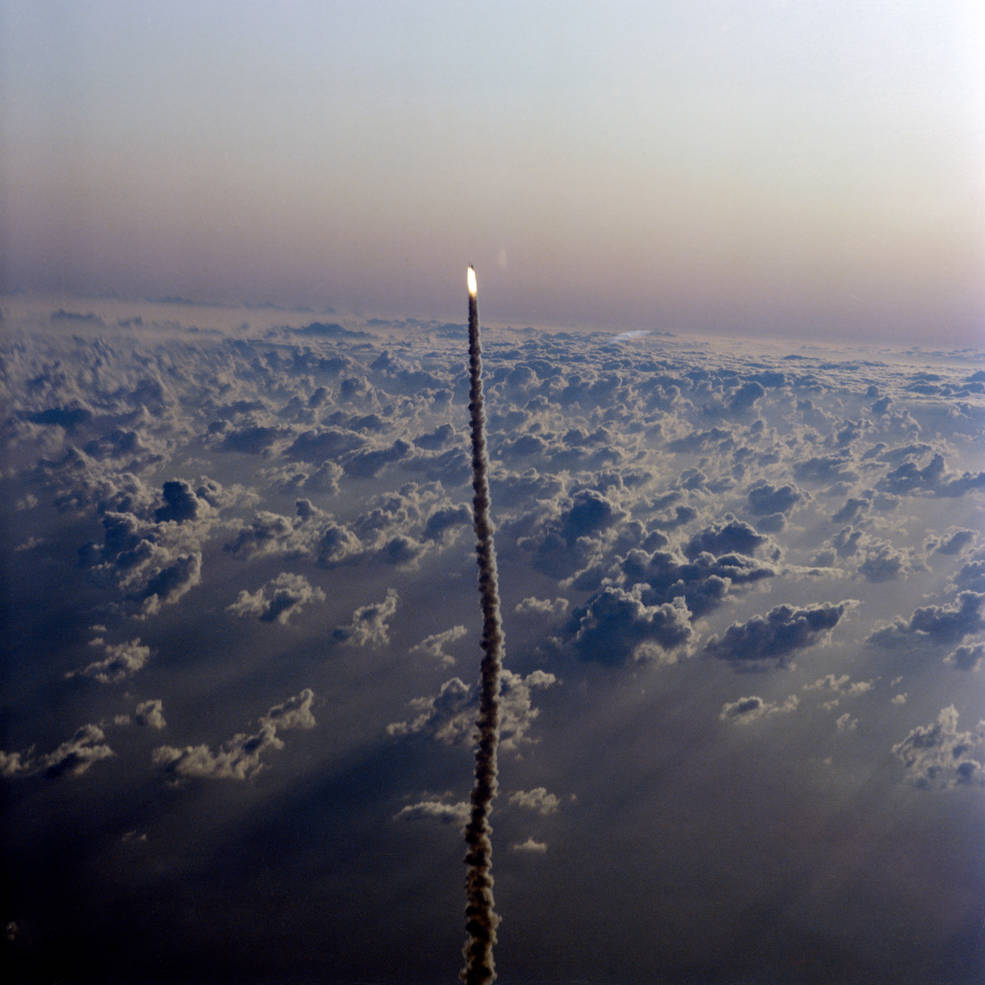
Left: The STS-5 crew of Robert F. Overmyer, front left, Vance D. Brand, William B. Lenoir, read left, and Joseph P. Allen leave astronaut crew quarters for the ride to Launch Pad 39A at NASA’s Kennedy Space Center in Florida. Middle: Liftoff of space shuttle Columbia on the STS-5 mission. Right: Photograph from a chase plane of space shuttle Columbia’s ascent into orbit.
At 7:19 a.m. EST on Nov. 11, 1982, space shuttle Columbia lifted off from Launch Pad 39A, carrying its crew of four astronauts and payload of two commercial satellites. For the first time, an astronaut, in this case Allen, rode in the middeck during launch with Lenoir serving as a flight engineer sitting behind Brand and Overmyer on the flight deck. As soon as the shuttle cleared the launch tower, control of the flight handed over to the Mission Control Center (MCC) at NASA’s Johnson Space Center (JSC) in Houston. The Ivory Team of flight controllers led by ascent Flight Director Thomas W. “Tommy” Holloway monitored Columbia’s ascent, with capsule communicator (capcom) astronaut Robert L. Stewart relaying milestone events to the crew aboard the shuttle. About two minutes after liftoff, the two solid rocket boosters (SRBs) exhausted their fuel and were jettisoned. Columbia continued its ascent on the power of its three main engines. Eight and a half minutes after liftoff, Columbia’s main engines shut off on time and the large external tank was jettisoned. The space shuttle had reached space but had not yet achieved orbit. Columbia’s two Orbital Maneuvering System (OMS) engines fired twice to complete the task of placing the vehicle into a circular 184-mile-high orbit. The first major task involved Overmyer opening the orbiter’s payload bay doors to allow the radiators mounted inside them to cool the vehicle. With the payload bay now exposed, Lenoir closed the sunshields on the two satellites to prevent them from overheating. Shortly after, President Ronald W. Reagan called the crew to congratulate them on the great start to their mission.
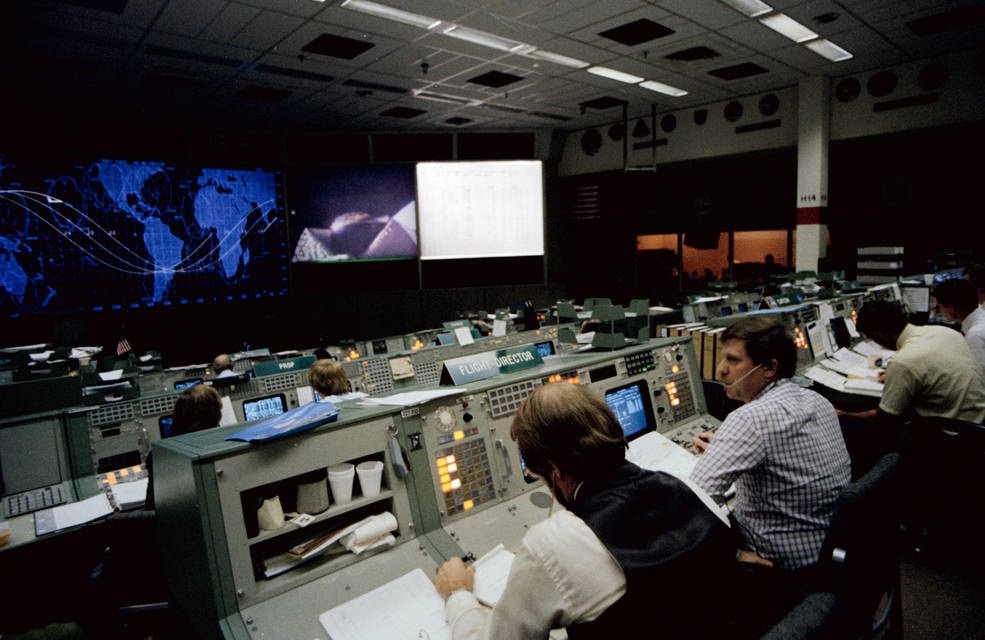
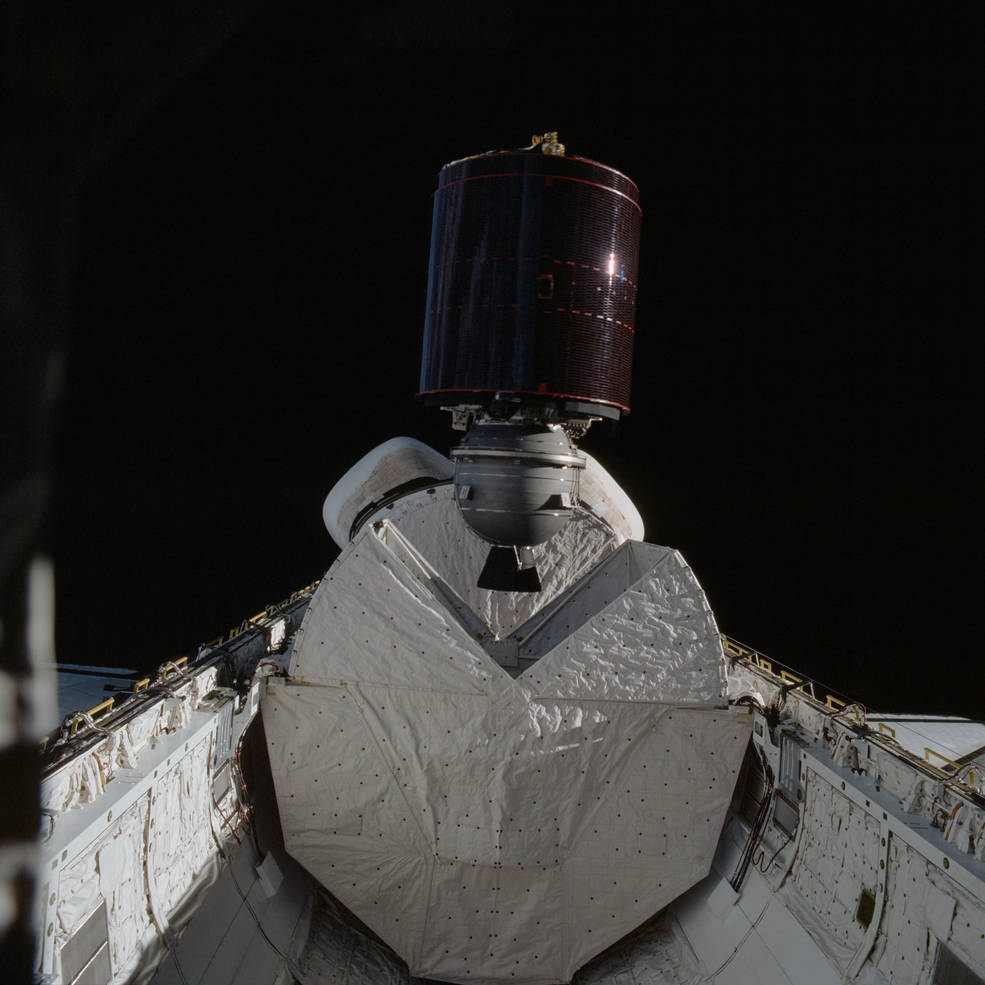
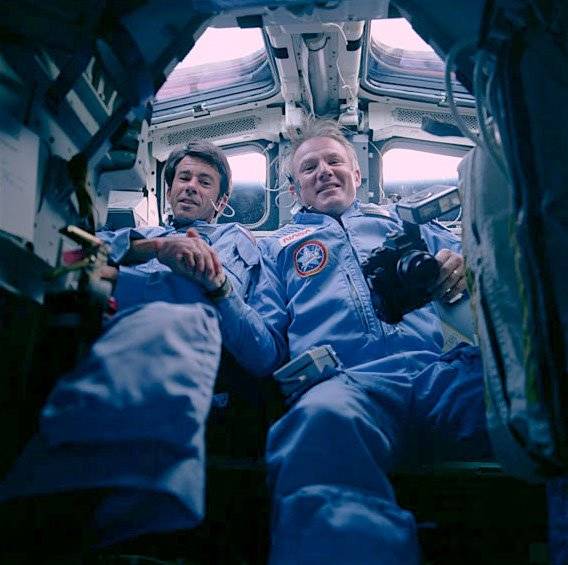
Left: View in the Mission Control Center at NASA’s Johnson Space Center in Houston during the first day of the STS-5 mission, just prior to the deployment of the SBS-3 satellite. Middle: Deployment of the SBS-3 communications satellite, the first satellite deployed from the space shuttle. Right: William B. Lenoir, left, and Vance D. Brand congratulate each other on the first deployment of a satellite by the space shuttle.
At about eight hours into the mission, Lenoir deployed the SBS-3 satellite from the shuttle’s payload bay. Brand maneuvered the shuttle away from the deployed satellite to avoid any recontact and to place some distance between the two objects. The satellite’s attached two-stage Payload Assist Module-D (PAM-D) kick motor then fired to begin the process of placing it into its 22,300-mile-high geosynchronous operational orbit. The crew completed some housekeeping chores, ate their evening meal, and settled down for their first night’s sleep in space.
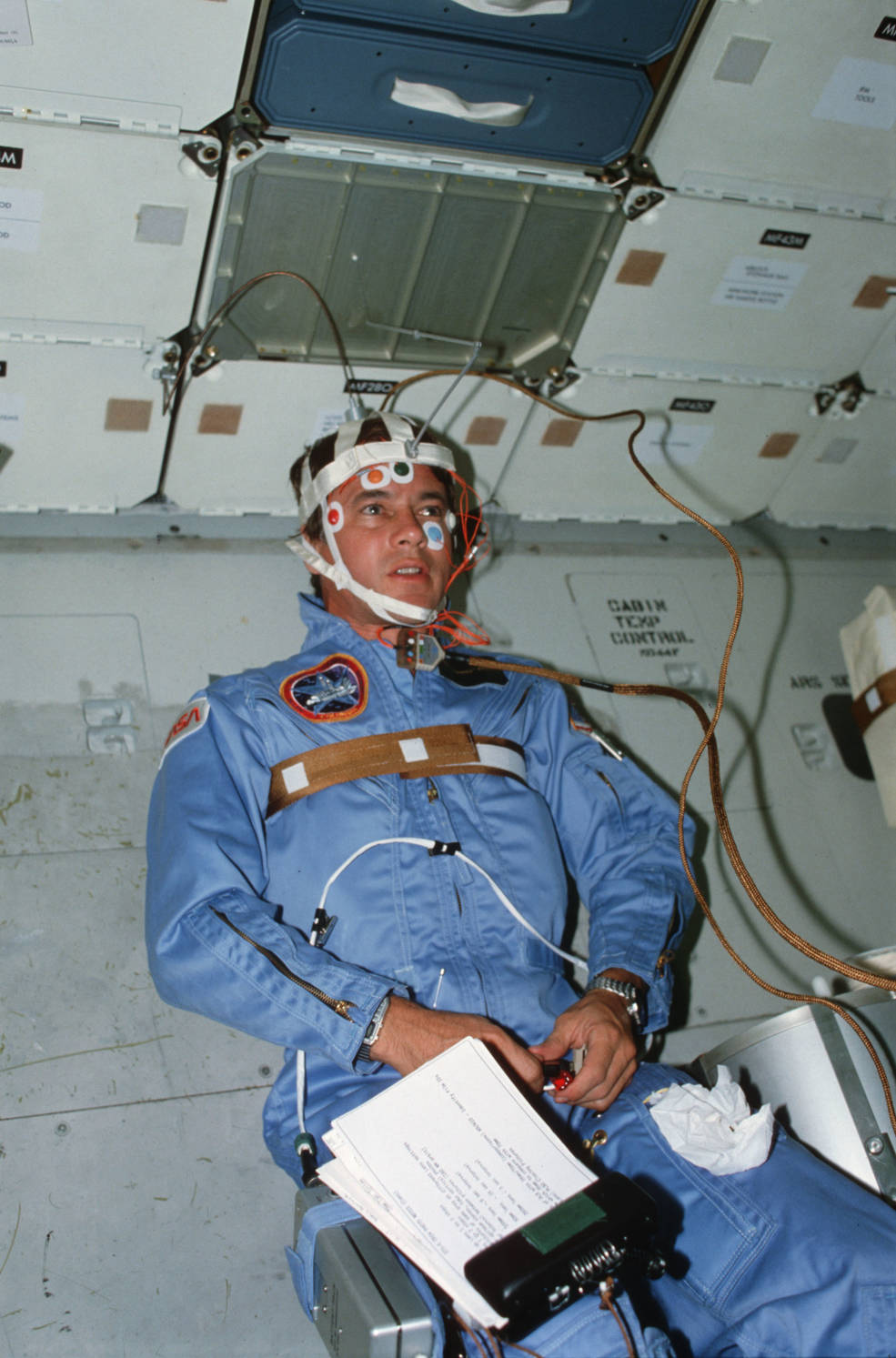
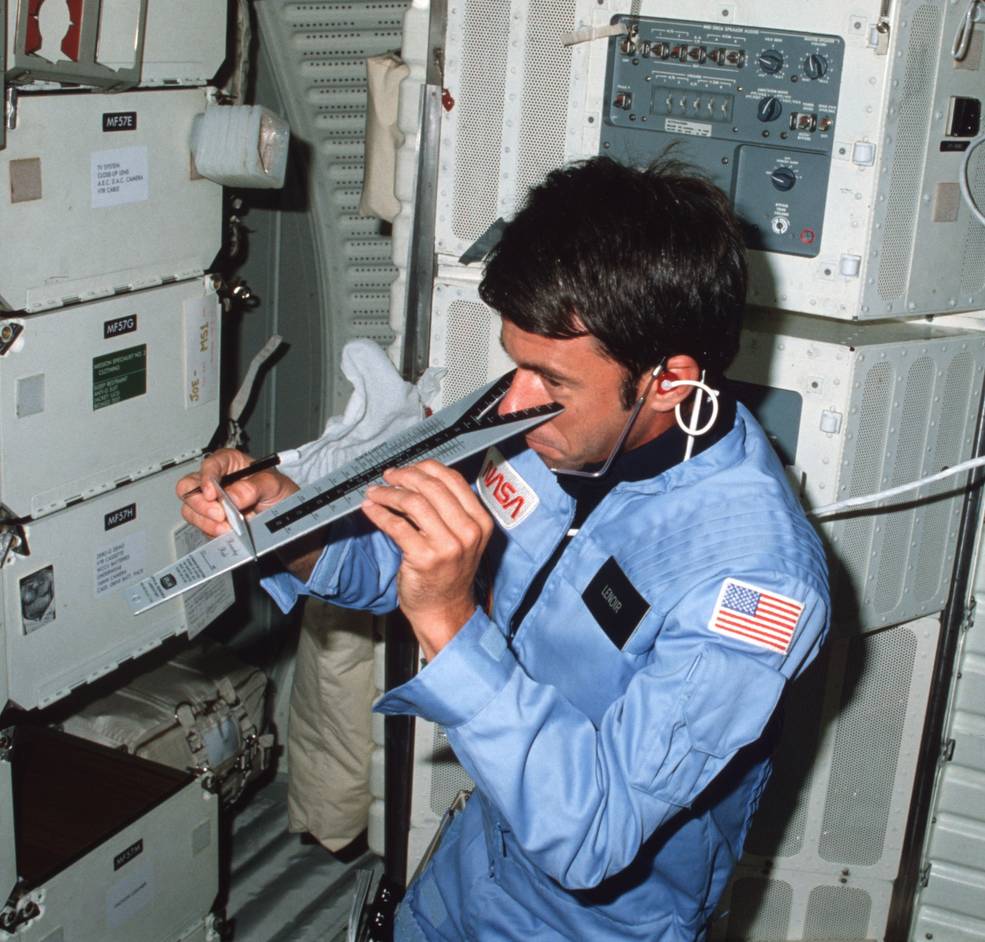
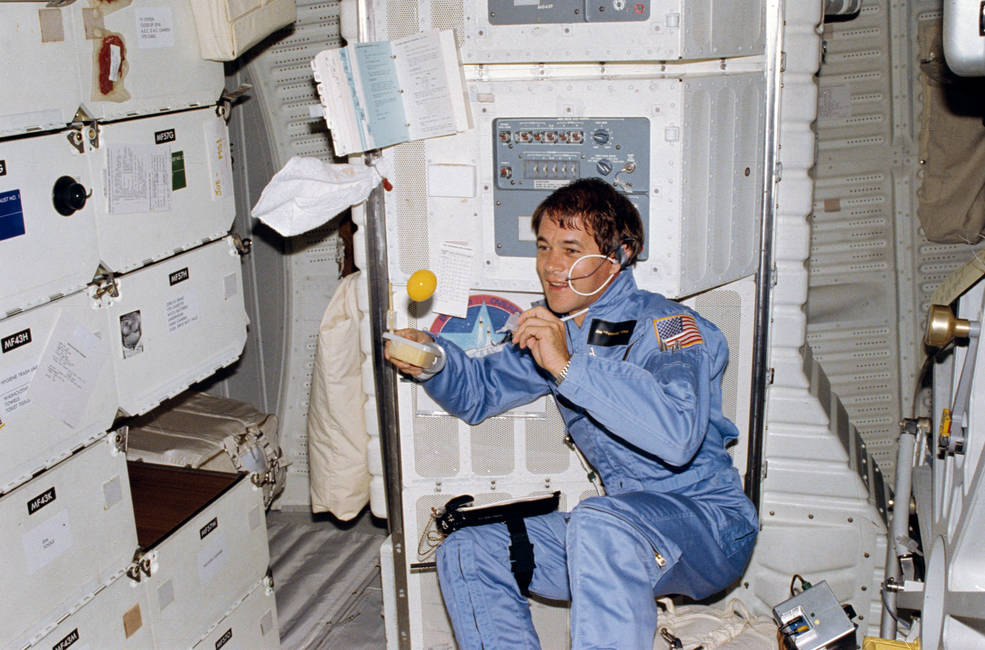
Left: STS-5 astronaut Joseph P. Allen conducts a study of head and eye movements. Middle: STS-5 astronaut William B. Lenoir conducts a visual acuity test. Right: Allen conducts an impromptu physics demonstration with a globule of orange juice.
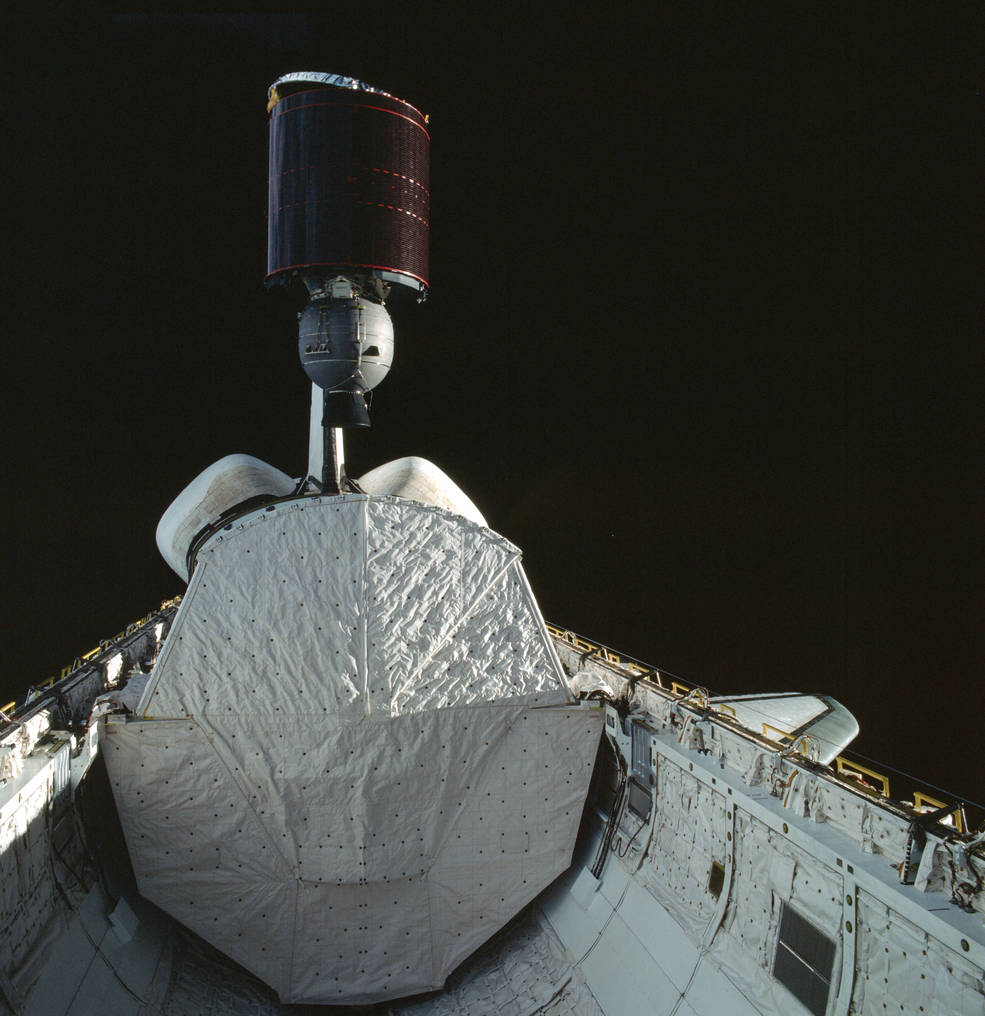
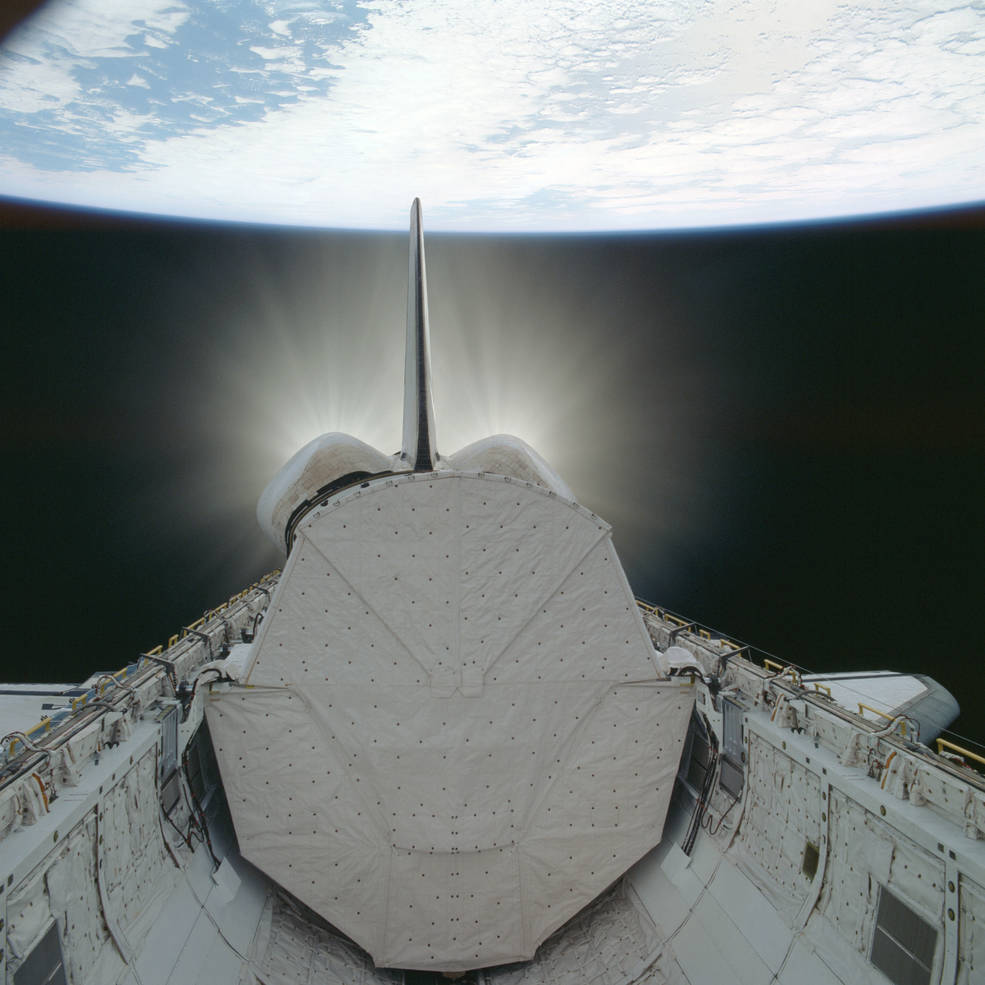
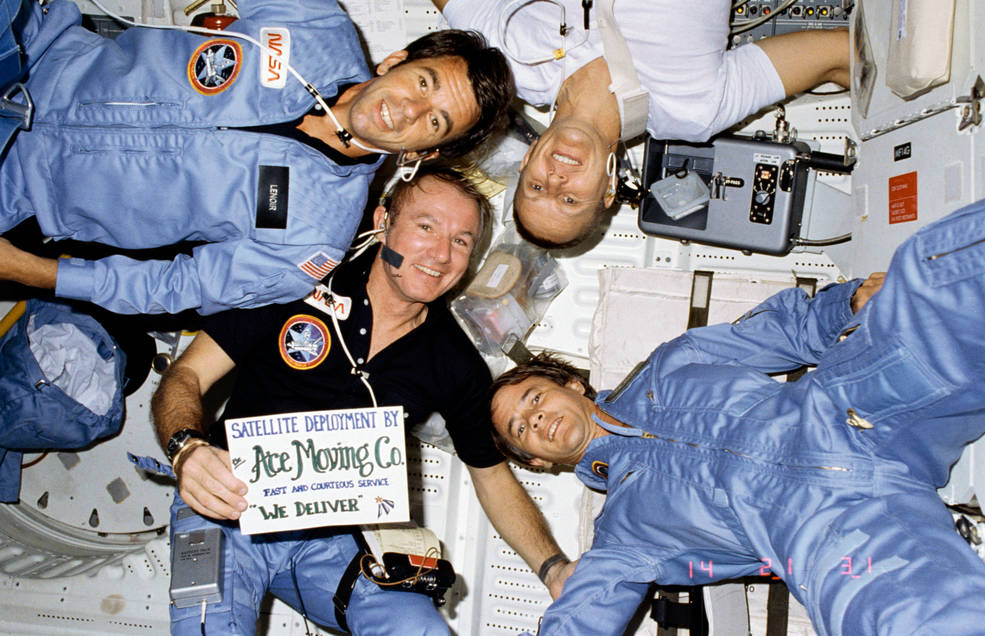
Left: Deployment of Telesat Canada‘s Anik C3 satellite. Middle: Firing of Columbia’s Orbital Maneuvering
System engines. Right: The STS-5 crew of William B. Lenoir, left, Vance D. Brand, Joseph P. Allen, and
Robert F. Overmyer hold a sign saying “Ace Moving Co.” following the deployment
of the two communications satellites.
To begin their second day in space, Mission Control woke the crew up with the song “76 Trombones” from the musical “The Music Man.” Allen and Lenoir conducted a session of a head- and eye-motion test, part of a series of experiments designed by astronaut Dr. William E. Thornton to better understand astronauts’ susceptibility to space motion sickness. They also activated the protein crystal growth and sponge growth student experiments. They next completed two short OMS burns to test the engines’ cold restart capabilities. Allen deployed the Anik C3 satellite in a virtual repeat of the previous day’s deployment. Following the second satellite’s departure, Allen commented, “We are two for two. We deliver.” Columbia fired its engines to separate from the satellite prior to its PAM-D engine firing. With the satellite deployments behind them, the crew settled down for their evening meal and began their second sleep period in space.
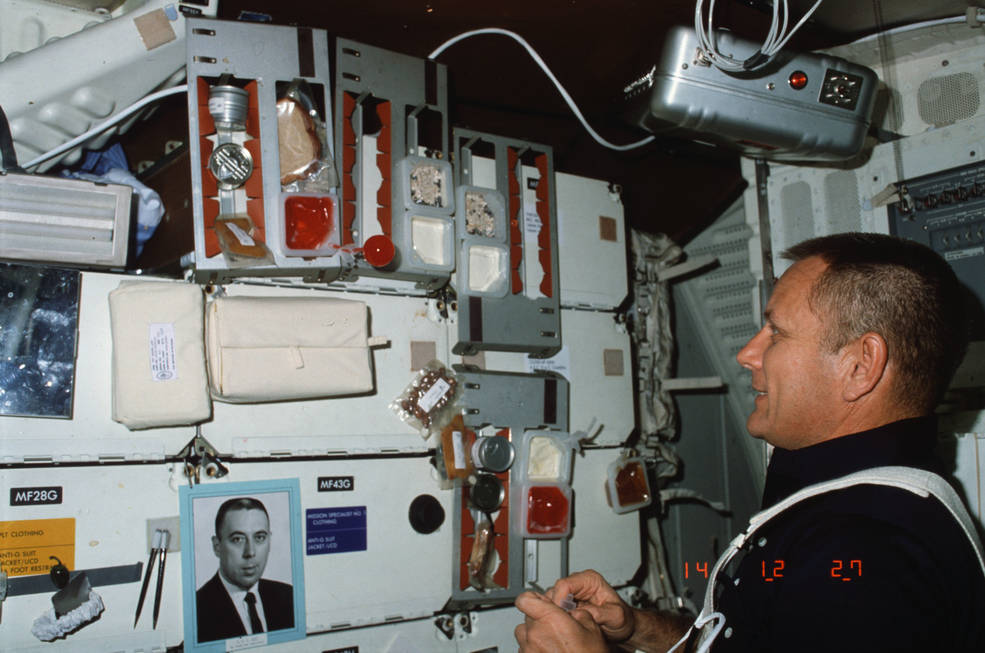
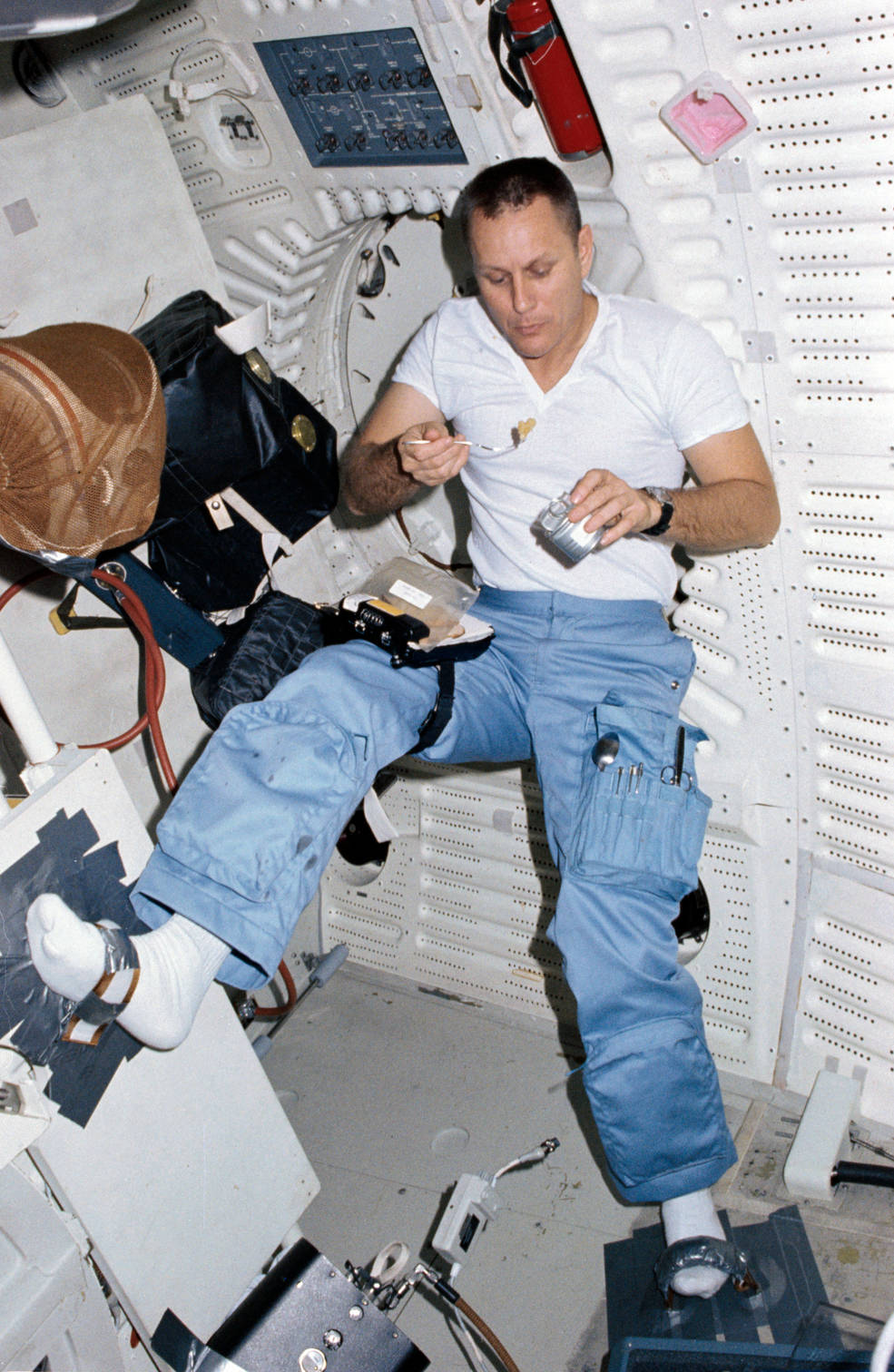
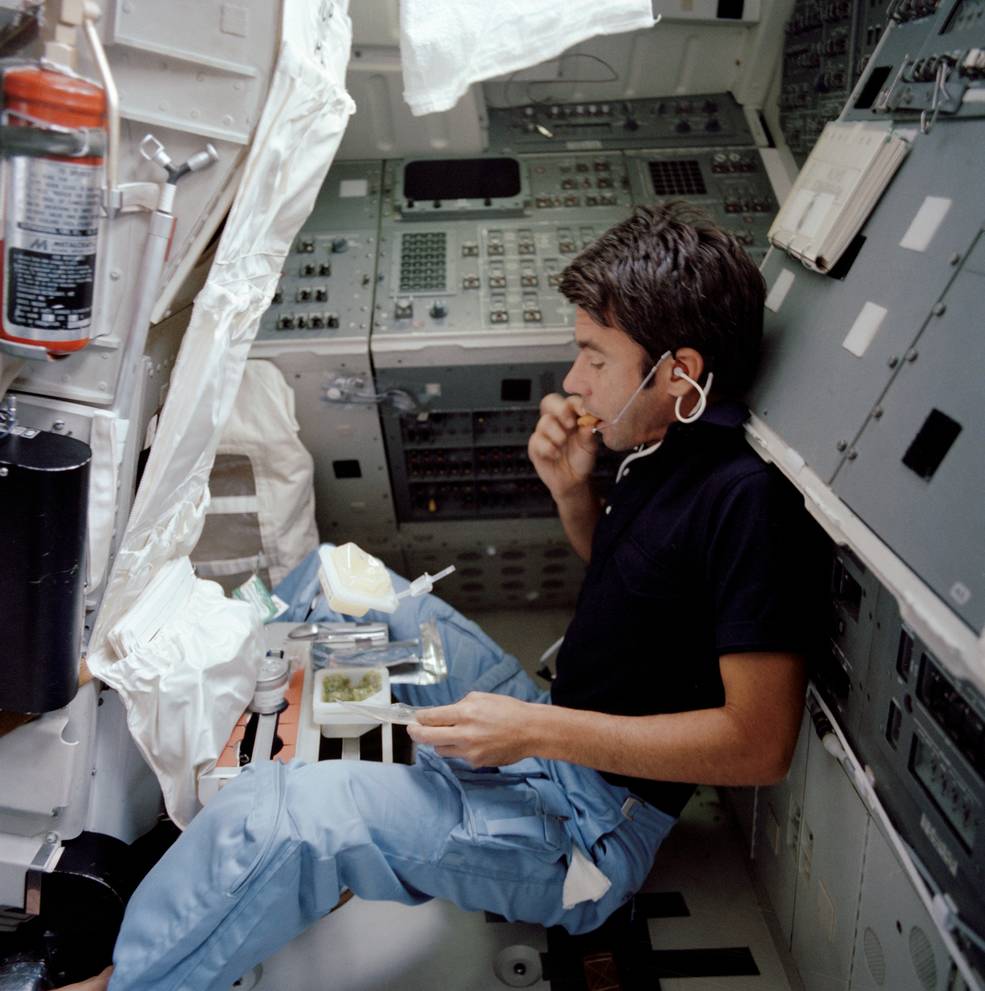
Left: STS-5 astronaut Robert F. Overmyer prepares a meal for the crew. Middle: Overmyer uses foot restraints to anchor himself as he eats a meal. Right: William B. Lenoir eats a meal on the middeck.
For their second wake up call, Mission Control piped up the country and western song “Cotton-Eyed Joe.” In the morning, following their breakfast, the astronauts completed a test of the shuttle’s reaction control system thrusters. Dr. Sam L. Pool, chief of the Medical Sciences Division at JSC, reported that two of the astronauts experienced symptoms of space motion sickness and took medications to alleviate the symptoms. Overmyer had recovered while Lenoir continued to experience symptoms. Lenoir and Allen began preparing for their spacewalk, planned for the next day. They began to assemble all the equipment needed for the excursion outside the spacecraft, expected to last about 3.5 hours, and Mission Control watched some of the activities as the astronauts downlinked television views from the middeck. Just before the astronauts began their sleep period, capcom Jon A. McBride informed Brand of the decision to delay the spacewalk by one day to allow Lenoir to fully recover.

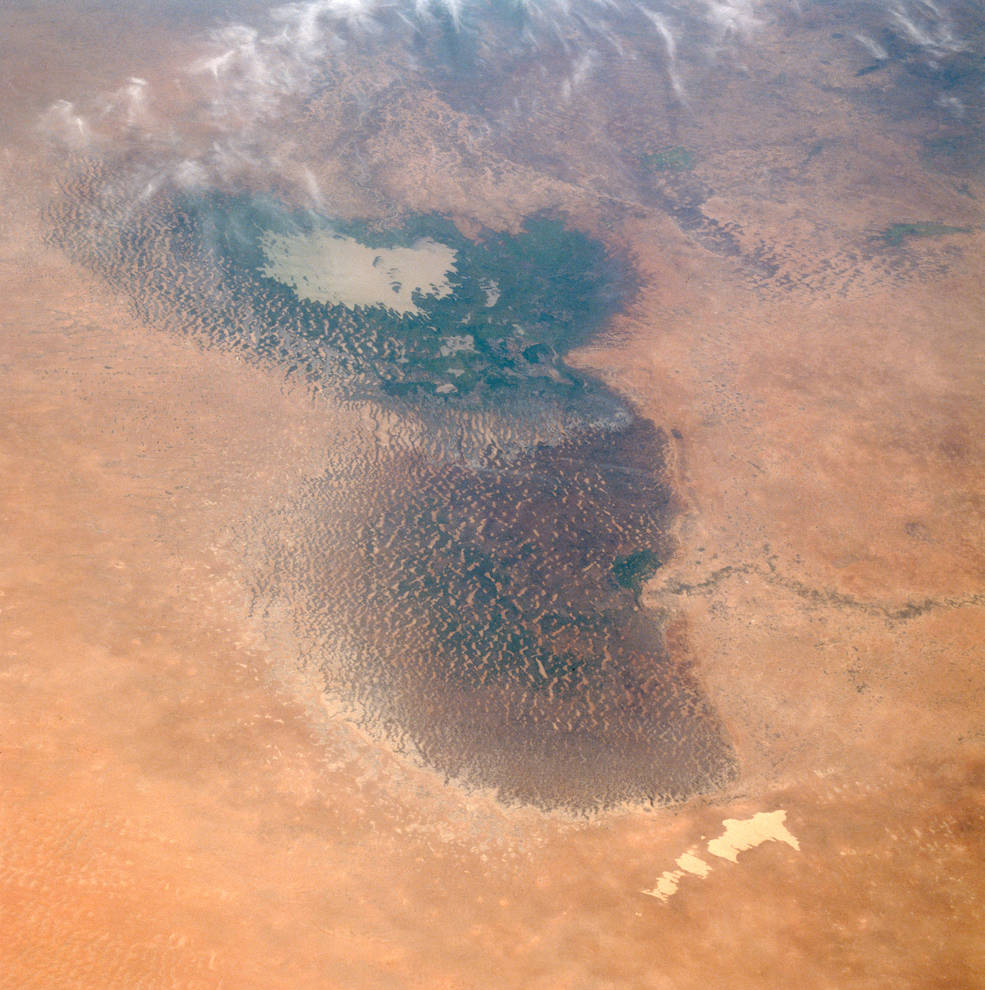
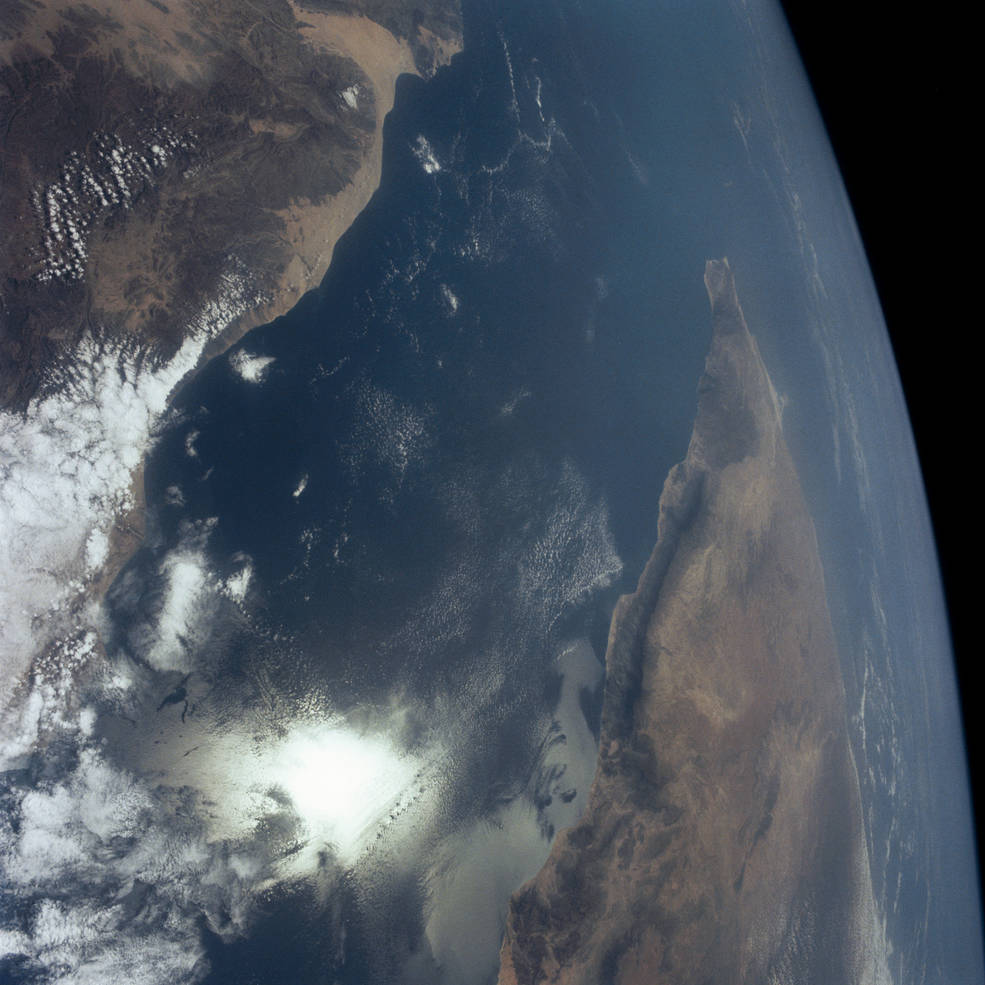
Earth observation photographs taken by the STS-5 crew. Left: Lake Chapala and Guadalajara in Mexico. Middle: Lake Chad, where Chad, Niger, Nigeria, and Cameroon meet. Right: Eddies in the Gulf of Aden, with Yemen at the top and Somalia at the bottom.
Mission Control allowed the astronauts to sleep an extra 30 minutes and began their fourth day in space by playing the Marine Corps Hymn “From the Halls of Montezuma,” in honor of Brand, a former Marine Corps aviator, and Overmyer, a colonel in the Marine Corps. Lenoir’s condition had dramatically improved overnight, and flight surgeons expected his full recovery by the end the day and remained confident that he would be able to conduct the spacewalk the next. Both Lenoir and Allen conducted more sessions of Dr. Thornton’s space motion sickness studies, and Allen worked on the student experiment studying convection in space, including providing downlinked video. The crew then began their sleep period.
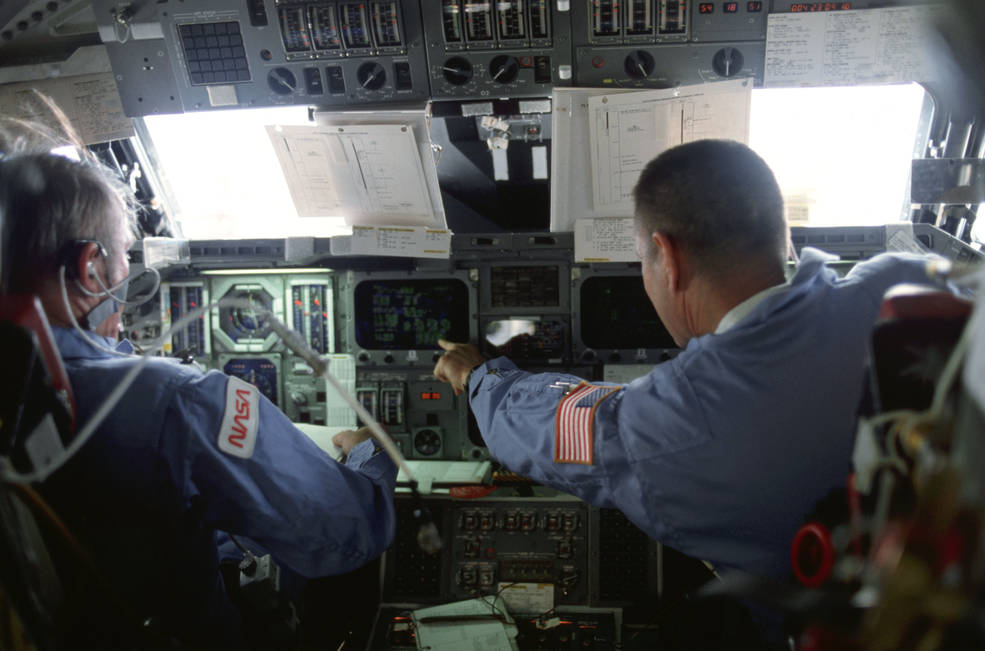
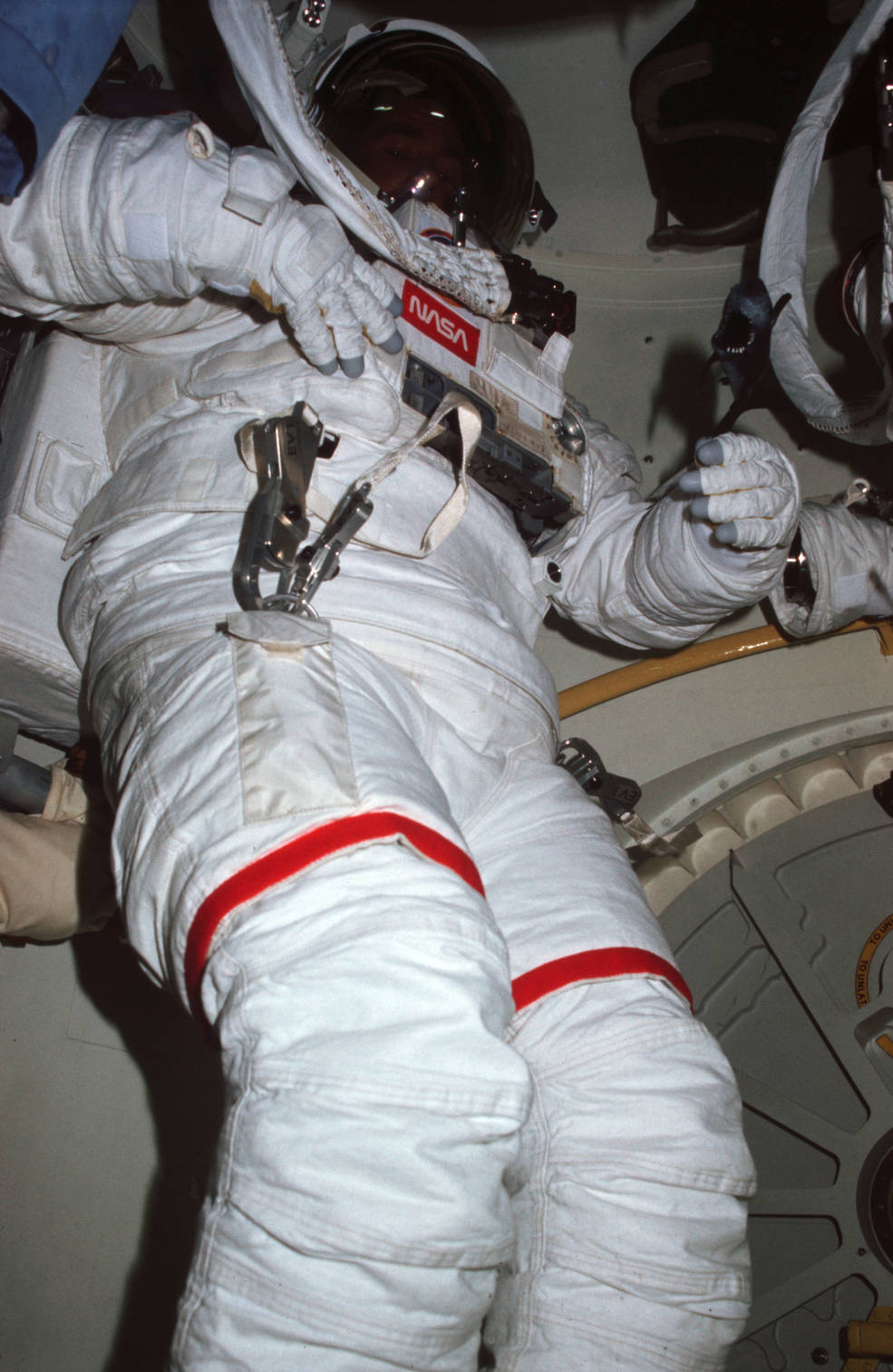
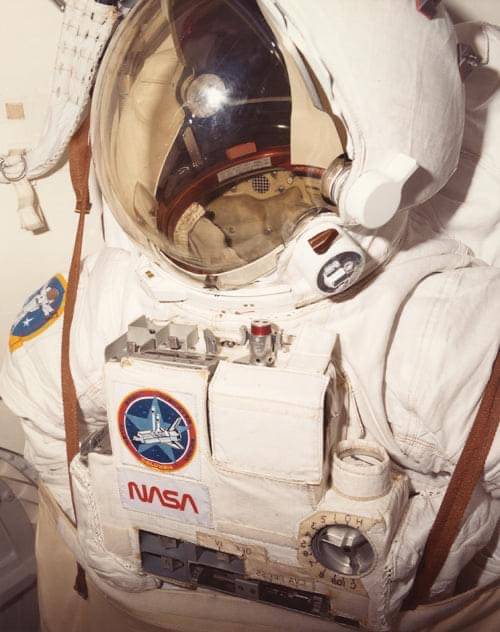
Left: STS-5 astronauts Vance D. Brand, left, and Robert F. Overmyer on the flight deck of Columbia. Middle: STS-5 astronaut William B. Lenoir conducts tests of his spacesuit following the failure of its pressure regulator. Right: One of the STS-5 spacesuits stowed away in Columbia.
In honor of the planned spacewalk, the astronauts’ fifth day in space began with “The Stroll” by 1950s band The Diamonds as their wakeup music. Lenoir and Allen almost immediately began preparing for their spacewalk. They had completed most of the preparatory work the evening of their third day, so they moved through the timeline quickly. First Lenoir, then Allen donned their spacesuits, known formally as Extravehicular Mobility Units, specially designed for use on the space shuttle. After they both donned their helmets to begin the four-hour prebreathe with pure oxygen to rid their blood of nitrogen, Allen’s suit fan came on and then shut off. Cycling the fan led to the same result. The astronauts and Mission Control began troubleshooting the problem, at first believing water trapped on the fan might be the problem. Without a working fan, Allen began to overheat so he removed his suit. As troubleshooting continued on Allen’s suit, Mission Control called up an alternate plan to have Lenoir begin his prebreathe and then conduct a solo test of his suit with the airlock depressurized but without exiting out to the payload bay. When Lenoir conducted a leak check of his suit, it only reached 3.8 pounds per square inch (psi) instead of the required 4.3 psi. Without a properly working pressure regulator in Lenoir’s suit, Flight Director Holloway decided to cancel the spacewalk – it would have to await a later shuttle mission. Lenoir and Allen, with Overmyer’s help, continued troubleshooting both suits, including pressurizing Allen’s suit without him in it to see if it could hold the required 4.3 psi. It eventually did, but without a working fan it still could not support the required prebreathe protocol. One final attempt had Lenoir put his suit back on and depressurize the airlock from 14.7 psi to 9 psi to see if that would fix the regulator, but without success. Instead of the next scheduled television broadcast from Columbia showing a spacewalk, the astronauts demonstrated life aboard the space shuttle, including Overmyer shaving in weightlessness, Allen showing how a gyroscope works, and Allen and Lenoir demonstrating how the gyroscope principle applied to the two satellites they deployed. They also showed video of the Earth below as Columbia passed over Florida and the Bahamas. At the end of the transmission, the astronauts packed up and stowed the spacesuits in anticipation of the landing the following day.
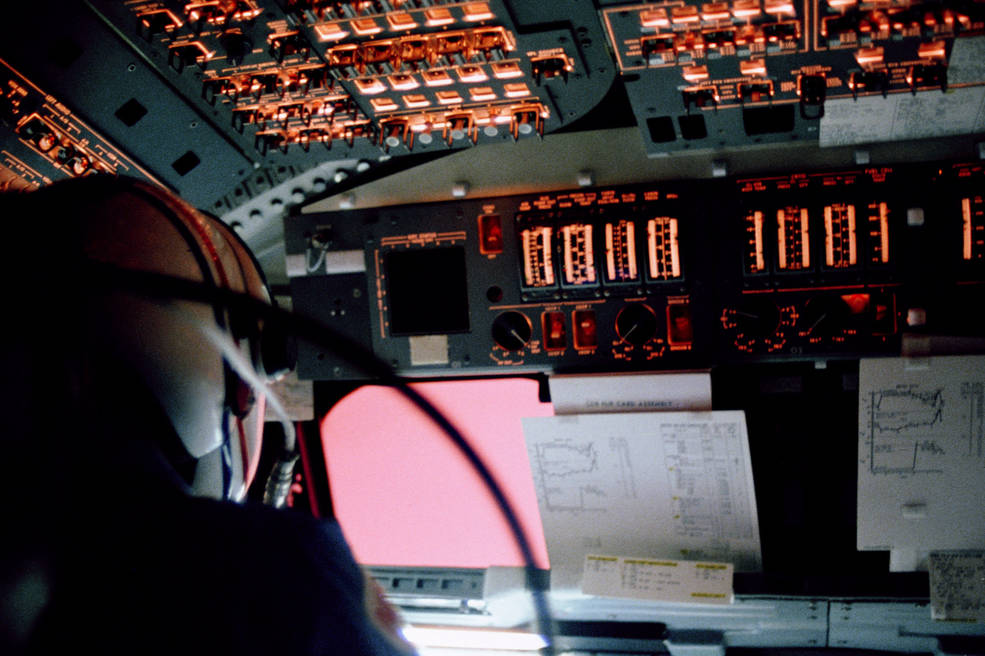
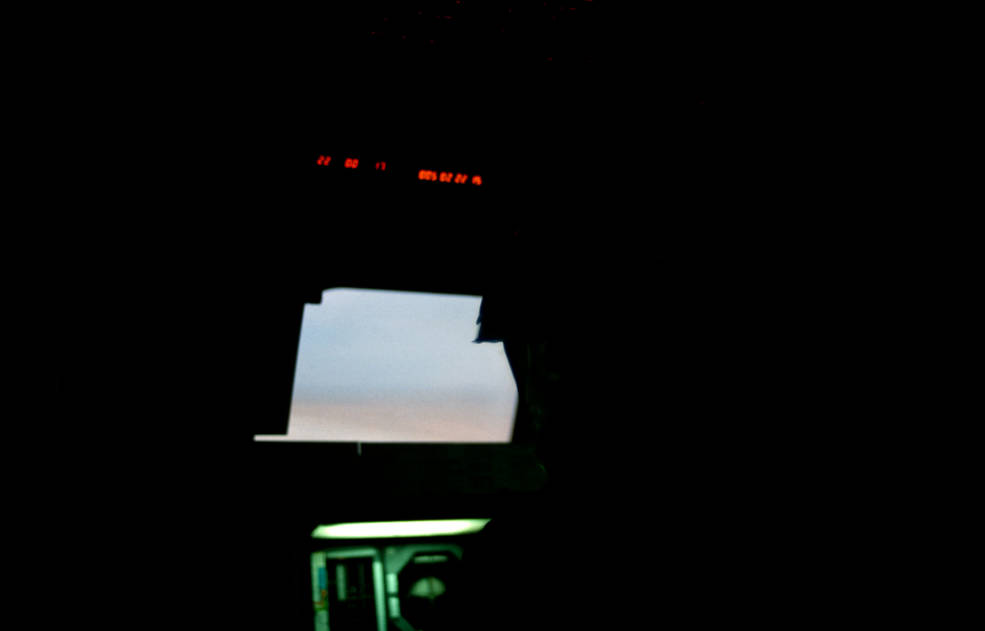
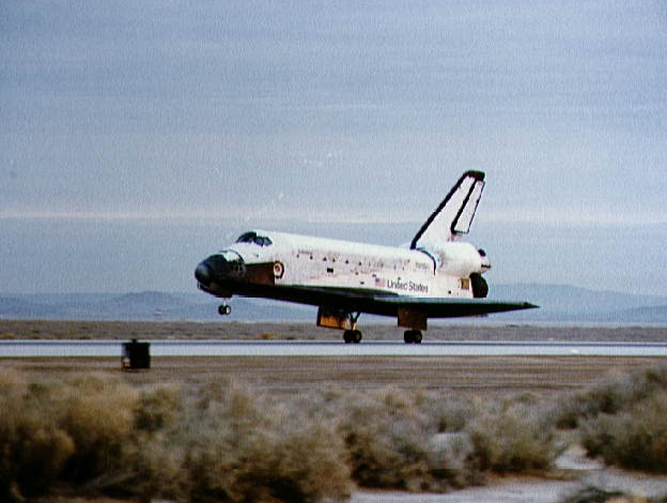
Left: The pinkish glow of reentry is visible through a forward cockpit window past STS-5 astronaut Vance D. Brand during reentry. Middle: The California desert is visible through a forward cockpit window past STS-5 astronaut Robert F. Overmyer during the approach to Edwards Air Force Base in California. Right: TOUCHDOWN! Columbia touches down on the concrete runway at Edwards.
For the astronauts’ final day in space, Nov. 16, Mission Control chose John Denver’s “Country Roads” as the wakeup music. Flight Director Gary E. Coen and capcom McBride, both from West Virginia, likely chose the song. They soon relinquished theirs consoles in Mission Control to Holloway’s team for the landing, with Stewart and Bridges once again serving as capcoms. After their breakfast the STS-5 crew finished some last-minute stowage, received weather updates from Stewart and then closed the payload bay doors in preparation for the reentry burn. They completed their fluid loading to prevent symptoms of lightheadedness after returning to Earth’s gravity and donned their launch and entry helmets. The astronauts took their seats in the vehicle, with Allen and Lenoir switching their launch positions, Allen now serving as flight engineer on the flight deck and Lenoir seated below in the middeck. On their 81st and final orbit of the Earth, over the Indian Ocean, they fired Columbia’s OMS engines for two and a half minutes to drop them out of orbit. Columbia encountered the first tendrils of the Earth’s upper atmosphere at an altitude of 400,000 feet. The heat of reentry caused a sheath of ionized plasma to form around the vehicle, temporarily blocking communications. They crossed the California coast just south of Santa Barbara at an altitude of 100,000 feet and traveling at Mach 4. By the time they flew a circle over Edwards Air Force Base in California’s Mojave Desert, they had dropped to 50,000 feet and below the speed of sound. Seven minutes after local sunrise, Brand guided Columbia to a smooth landing on concrete Runway 22, performed a maximum braking test, and rolled it to stop. At wheels stop, Brand called out, “Yes, sir. We deliver. Nice to be back.” From Mission Control, capcom Bridges replied, “Lot of applause here in the room and we’re very happy to have all you guys home again.” The mission of STS-5 had lasted 5 days, 2 hours, and 14 minutes.
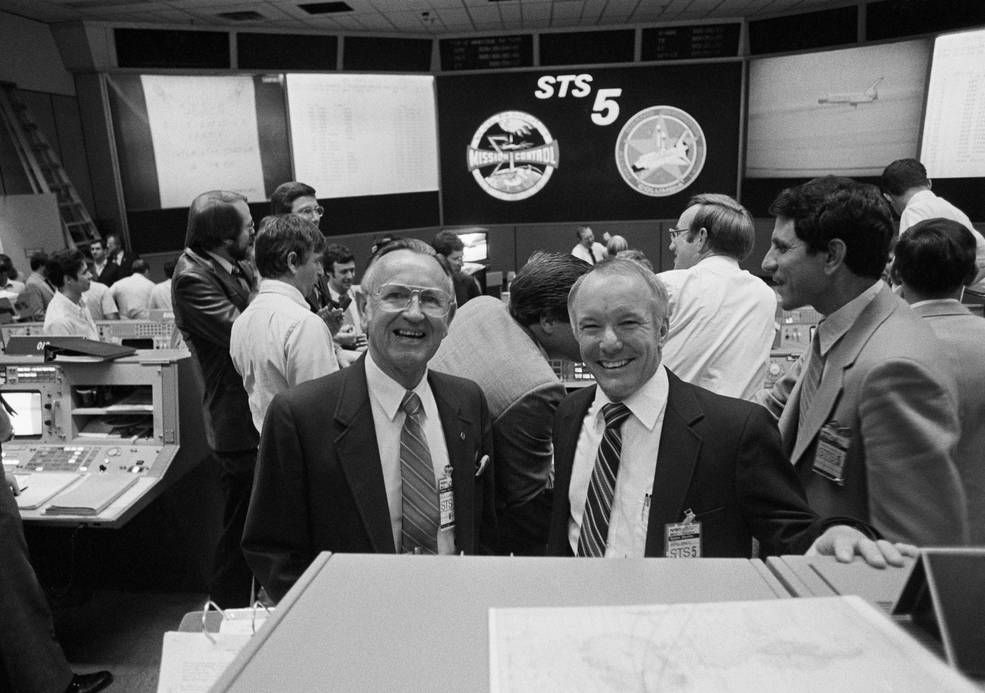
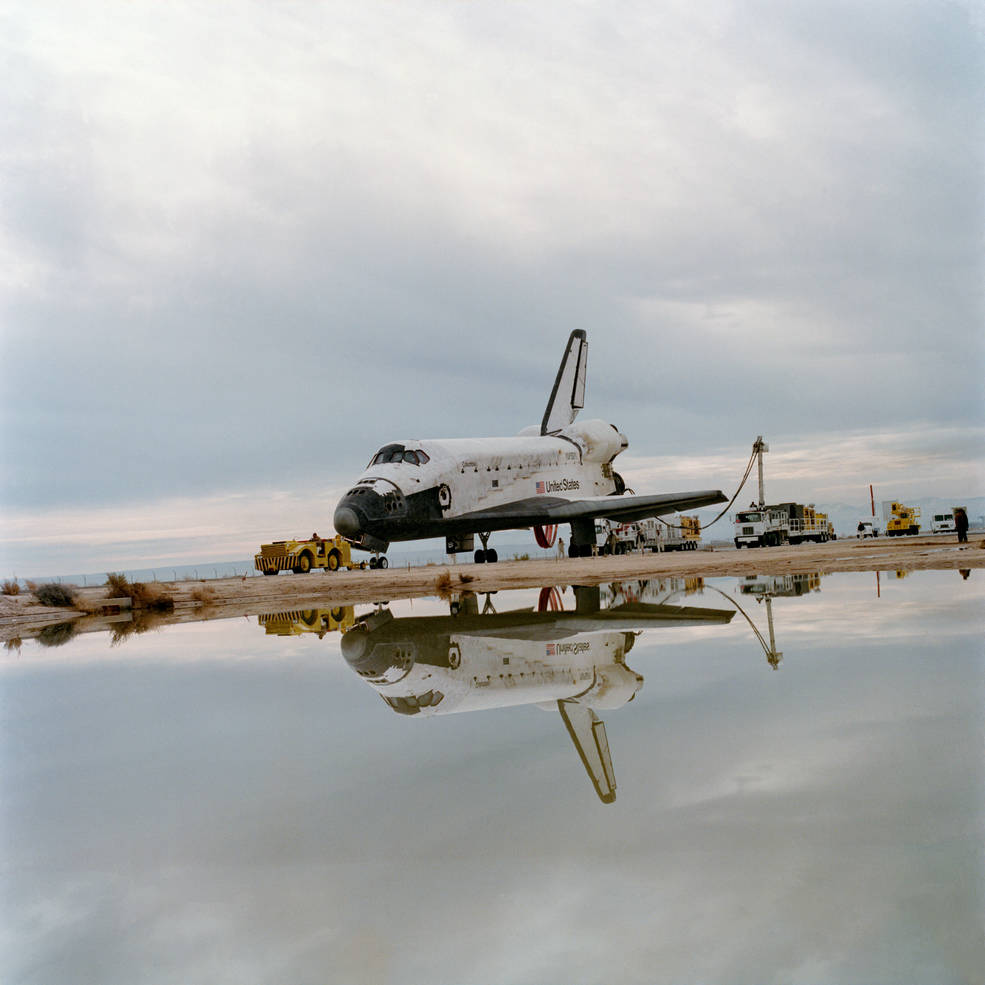
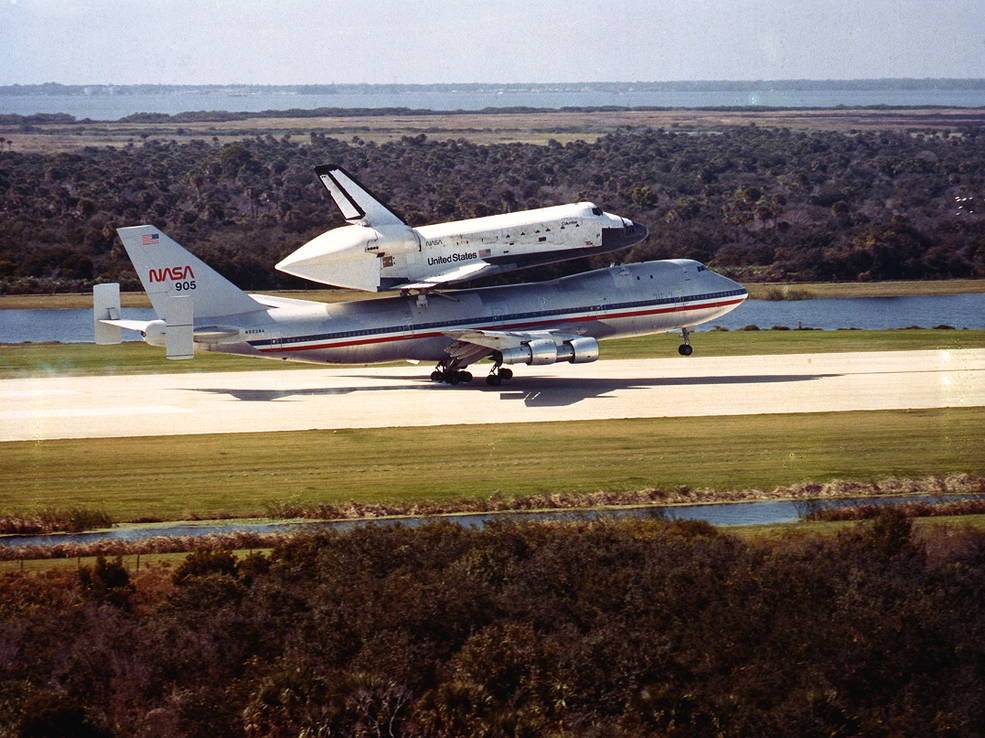
Left: Christopher C. Kraft, left, former director of NASA’s Johnson Space Center (JSC) in Houston, and JSC Director Gerald D. Griffin stand in Mission Control following the conclusion of the STS-5 mission. Middle: Ground crews prepare to tow Columbia from the runway at Edwards Air Force Base in California. Right: The Shuttle Carrier Aircraft ferrying Columbia arrives at NASA’s Kennedy Space Center in Florida.
After exiting Columbia, Brand, Overmyer, Lenoir, and Allen conducted a brief walkaround of the orbiter to inspect it for any damage. In a brief ceremony, NASA Administrator James M. Beggs welcomed them back to Earth. The astronauts reunited with their families and soon boarded a plane for the flight back to Houston’s Ellington AFB near JSC, where a large crowd of well-wishers greeted them. On Dec. 1, the STS-5 crew held a press conference, during which they narrated a film about their mission. Meanwhile at Edwards, ground crews towed Columbia from Runway 22 to the Mate Demate Device (MDD) for a postflight inspection, finding it in remarkably good shape. They mounted the orbiter atop the Shuttle Carrier Aircraft (SCA), a modified Boeing 747, for the ferry flight back to KSC, arriving there on Nov. 22. In KSC’s OPF, Columbia spent several months undergoing significant modifications to accommodate the European-built Spacelab module on its next trip into space on the STS-9 mission in November 1983. The modifications also included removal of the two ejection seats, allowing four astronauts to ride on the flight deck, thus accommodating that mission’s six-member crew. In the interim, the space shuttle fleet’s second orbiter, Challenger, flew missions STS-6, 7, and 8.
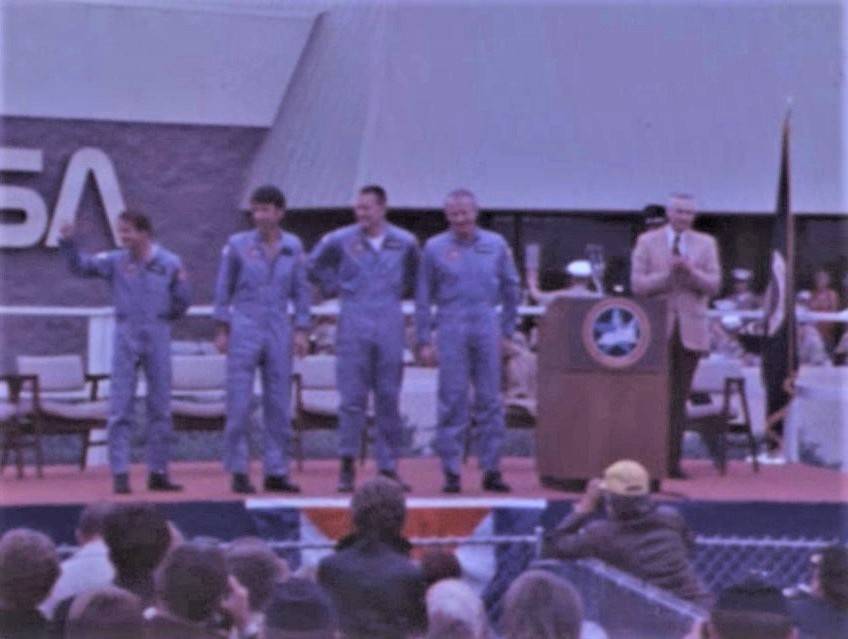
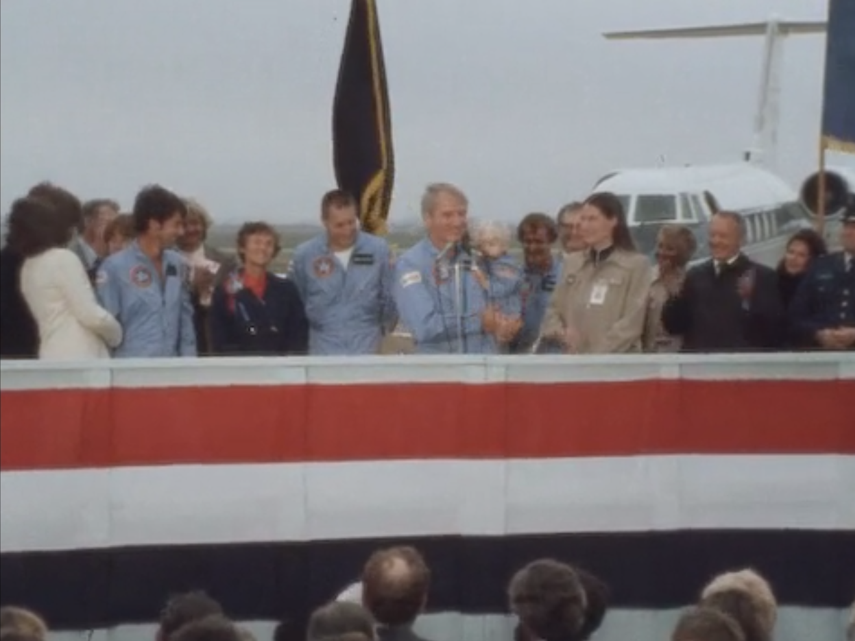
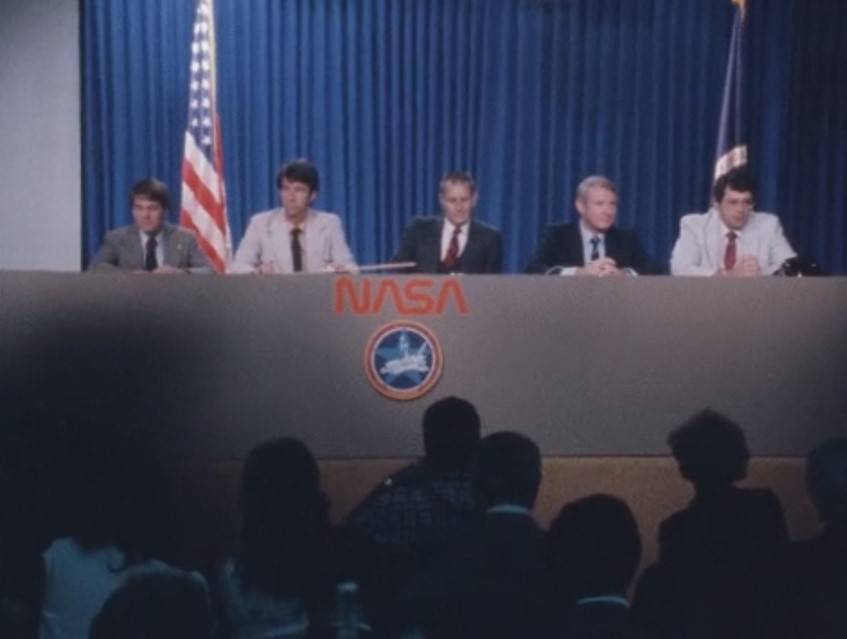
Left: NASA Administrator James M. Beggs, right, greets STS-5 astronauts Joseph P. Allen, left, William B. Lenoir, Robert F. Overmyer, and Vance D. Brand at Edwards Air Force Base (AFB) in California. Middle: Lenoir, left, Overmyer, Brand, and Allen and their families greet the welcome home crowd at Houston’s Ellington AFB. Right: Allen, left, Lenoir, Overmyer, Brand, and a public affairs officer during the STS-5 postflight crew press conference.



























